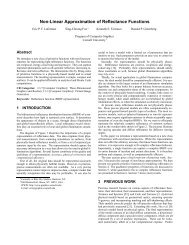pigmented colorants: dependence on media and time - Cornell ...
pigmented colorants: dependence on media and time - Cornell ...
pigmented colorants: dependence on media and time - Cornell ...
You also want an ePaper? Increase the reach of your titles
YUMPU automatically turns print PDFs into web optimized ePapers that Google loves.
4.2.2 Path tracing<br />
One approach to h<strong>and</strong>ling subsurface scattering is to directly simulate the micro-<br />
scopic light events at the molecular level. In the M<strong>on</strong>te Carlo approach, <strong>on</strong>e traces<br />
paths of many light phot<strong>on</strong>s through a volumetric material <strong>and</strong> develops a prob-<br />
abilistic model of the distributi<strong>on</strong> of light energy. As a path of light enters the<br />
material <strong>and</strong> experiences a scattering event, the ray is scattered <strong>and</strong> transmitted.<br />
Since integrating over the entire sphere at each scattering event is too costly, ’ran-<br />
dom’ samples are taken. If the material is isotropic (the scattering is independent<br />
of directi<strong>on</strong>), the appearance does not depend <strong>on</strong> the angle between the viewing<br />
directi<strong>on</strong> <strong>and</strong> the incoming light. If the scattering is anisotropic (dependent <strong>on</strong><br />
directi<strong>on</strong>), the method behaves better with n<strong>on</strong>uniform sampling <strong>and</strong> respective<br />
weighting. In general, for both cases in M<strong>on</strong>te Carlo algorithms, as the number of<br />
r<strong>and</strong>om samples increases, the summati<strong>on</strong> of those values c<strong>on</strong>verges toward the in-<br />
tegral. This method is used frequently in computer graphics due to its c<strong>on</strong>vergence<br />
rate <strong>and</strong> ease of operati<strong>on</strong>.<br />
It is typically assumed that (phase) scattering functi<strong>on</strong>s (the functi<strong>on</strong> that<br />
describes how the light behaves at the scattering event) describe scattering of<br />
a homogeneous distributi<strong>on</strong> of particles suspended in a medium. Usually, the<br />
particles are of equal size (or distributed in some reas<strong>on</strong>able way). Also, while the<br />
index of refracti<strong>on</strong> of both the particle <strong>and</strong> medium both influence the scattering<br />
of light, particle size exhibits more of an effect <strong>on</strong> the phase functi<strong>on</strong>.<br />
When the particles are much larger than the wavelength of light (particle diam-<br />
eter >> (380− 700nm)), the geometric particle objects dominate the reflectance.<br />
When the particle size approaches that of the wavelength of light, scattering events<br />
become much more evident. In this situati<strong>on</strong>, the complex theory of Mie scattering<br />
97



